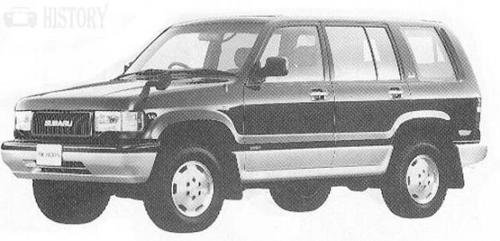Subaru Bighorn First generation
 | |
| Also called | Isuzu Rodeo Bighorn Isuzu Trooper/Trooper II (Pre-1989) Holden Jackaroo SsangYong Korando Family Subaru Bighorn |
|---|---|
| Production | 1981–1991 |
| Engine | 2.0 L G200 I4 (UBS13) 2.3 L 4ZD1 I4 (UBS16) 2.6 L 4ZE1 I4(UBS17) 2.2 L C223 diesel/turbodiesel I4(UBS52) 2.8 L 4JB1 diesel I4 2.8 L 4JB1-T turbodiesel I4 |
| Transmission | 4-speed Isuzu MSG manual 5-speed Isuzu MSG manual 5-speed Isuzu MAU5C manual 4-speed Aisin Warner automatic |
| Wheelbase | 3-door: 90.6 in (2,301 mm) 5-door: 104.3 in (2,649 mm) |
| Length | 3-door: 162.3 in (4,122 mm) 5-door: 176.0 in (4,470 mm) |
| Width | 65.0 in (1,651 mm) |
| Height | 3-door: 72.6 in (1,844 mm) 5-door: 71.7 in (1,821 mm) |
The first-generation Trooper was available as a three- or five-door, with a solid 4.555:1 rear axle and an independent front suspension. In the Japanese market, the car was originally introduced as the "Isuzu Rodeo Bighorn", but the "Rodeo" part of the name was soon dropped. Early engines included a 2.0-liter gasoline and a 73 PS (54 kW) 2.2-liter diesel, lightly powered even by early 1980s standards for the vehicle's 3,700 lb (1,680 kg) empty weight. The four-wheel-drive system was engaged by operating a three-position shifter adjacent to the transmission shifter. Both Aisin manual-locking and Isuzu's own auto-locking hubs were employed.
In 1986, Isuzu introduced the 4ZD1 four-cylinder 112 PS (82 kW; 110 hp) 2.3-liter engine, regarded as a considerable improvement over the previous gasoline engines because of its higher power, Kevlar timing belt replacing the chain driven ones in the 1.8l and 2.0l engines and improved and larger two-barrel carburetor. This engine eventually proved somewhat problematic with a plethora of burned valve problems because of the poor coolant flow design of the overhead cam/valve head with mechanical lifters A later head casting improvement by an Italian firm corrected this problem through improved coolant flow. Also available only for 1986 in the US was the 87 PS (64 kW) 2.2l C223T turbocharged diesel engine. It was not a popular option because of the low power generated. The C223T engine had a Garrett turbocharger and it actually performed admirably for its small size and ironically seemsto be the more dependable of the two engines offered that year because of its simplistic design and robust bottom end. Because of those problems, Isuzu changed the 4ZD1 for 1987 and used the standard 2.8L GM V6 for 1987 until their own new V6 engines could be manufactured.
In 1987, Isuzu introduced a 120 hp (89 kW) 2.6-liter (4ZE1) I-TEC fuel-injected engine for the US market. An optional General Motors 2.8-liter pushrod V6 borrowed from the Chevrolet S-10 pickup was also available. Manual transmission equipped models had a gear driven transfer case with a 2.28:1 low range ratio; models equipped with the 2.6-liter four-cylinder engine and automatic transmission had a 2.66:1 low range transfer case. Later first-generation models offered an optional four-speed automatic transmission. Models from 1988 to 1991 were equipped with live rear axles and four-wheel disc brakes. Also new in 1987 were rectangular headlights.
Overseas model engines included the Isuzu C223 (2,238 cc), C223T (a turbocharged version of the same) and in the late 80s naturally aspirated and turbocharged 2.8 L 4JB1 diesel versions, all straight-four engines. The turbocharged 2.8 originally produced 95 PS (70 kW), not much more than the 87 PS (64 kW) of the considerably smaller C223T due to new stricter emissions standards. Later versions with intercoolers fitted offered as much as 115 PS (85 kW).
In 1989 only, a short-wheelbase (90-inch) Isuzu Trooper was imported to the US market as the Trooper. All of these short wheelbase Troopers were equipped with 2.6-liter fuel-injected inline-four engines, 4.77:1 differential gears and 15×7-inch aluminium alloy "snowflake" pattern wheels. Automatic and manual transmissions were offered.
In Central America, Troopers were offered with removable roofs and a higher wheel clearance. Powertrain options included the Isuzu 2.8-liter turbo diesel.
In 1988, SsangYong Motors started licensed production of the Isuzu Trooper and sold it as the Korando Family, and was only marketed in South Korea, Southeast Asia and to a lesser degree South America. It used the same 2.2 L diesel engine but later versions used a 2.3 L Mercedes-Benz turbodiesel engine.


